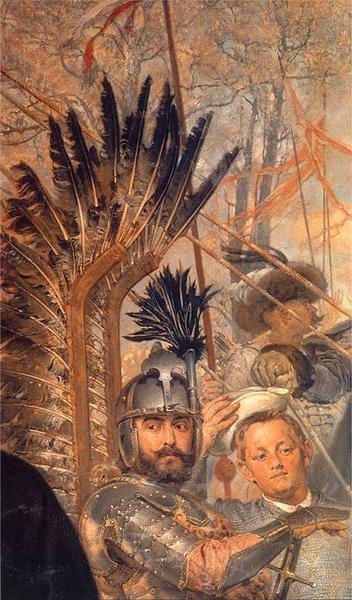Description
The work "Hetman of the Polish Crown in the seventeenth century", by the renowned Polish painter Jan Matejko, stands as a visual testimony not only of the figure of Hetman in Poland's military history, but also of the political and cultural concerns that They marked the time. Matejko, a master In the representation of historical issues, he uses his art to reveal the complexity of Polish identity and his cultural heritage, and this work is no exception.
The composition of the painting is intense and dynamic, which reflects a deep reverence towards the central figure of Hetman, generally a military leader of great prestige and responsibility. In it painting, The Hetman is represented with a splendid clothing that symbolizes its status within the Polish military and social hierarchy. His dressings, loaded with wealth and detail, also highlight the technical mastery of Matejko, who manages to transmit the magnificence of the character through careful attention to detail in ornaments and colors.
The use of color in this work is particularly remarkable. Matejko opts for a palette rich in golden golden, blue and red tones, which not only attract the viewer's gaze, but also evoke a feeling of power and dignity. The lighting seems to come from a strong focus, accentuating the heroic qualities of Hetman and creating a vibrant contrast with the background, which remains relatively gloomy. This color and light strategy not only serves to focus attention on the main figure, but also generates an atmosphere that suggests both greatness and severity, appropriate for a leader of such importance.
Hetman's expression is of determination and strength, characteristics that Matejko manages to capture with great effectiveness. The gesture of his hand, as well as the direction of his gaze, seem to invite the viewer to reflect on the future of the Polish nation in a context of challenges and uncertainties. Here lies one of Matejko's great virtues: his ability to transform historical figures into emblems of Polish identity, imbued with an almost epic sense.
The surrounding environment is also significant. Although the work does not show an explicit battle scene, the disposition and context suggest a proximity to historical conflicts. Related to other works by Matejko, this painting is part of its characteristic style, where patriotic fervor, history and representation of political power are intertwined with an outstanding pictorial mastery.
Jan Matejko, born in 1838 and died in 1893, is known for his ability to use painting as a means of historical narration. This specific work can be placed in a transition period for both art and Poland, at a time when the country fought for its cultural and political identity. The relevance of Hetman, as a historical figure, reflects the importance of military hierarchy in the Polish context, emphasizing the role of these figures in national defense and identity.
In conclusion, "Hetman of the Polish Crown in the seventeenth century" encapsulates not only a moment in Polish history, but a deep yearning for the greatness and dignity that defines the struggle of the nation. Matejko, with his sharp perception and his technical capacity, provides us with a window to the complexity of an era, causing this work to continue to resonate in the heart of the Polish cultural heritage.
KUADROS ©, a famous paint on your wall.
Hand-made oil painting reproductions, with the quality of professional artists and the distinctive seal of KUADROS ©.
Art reproduction service with satisfaction guarantee. If you are not completely satisfied with the replica of your painting, we refund your money 100%.

